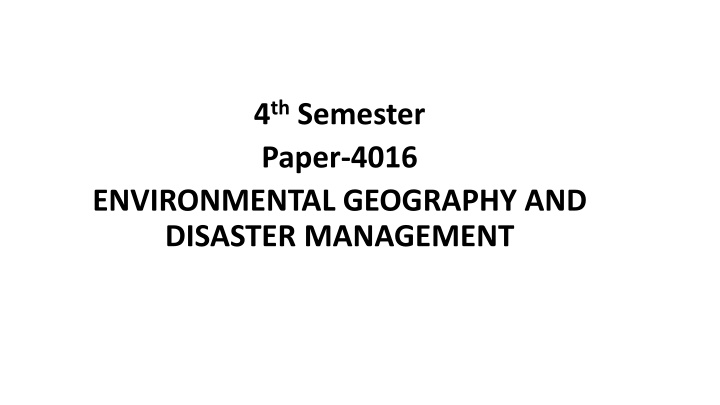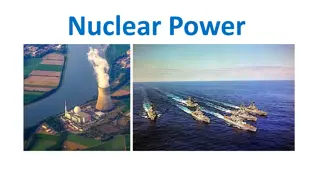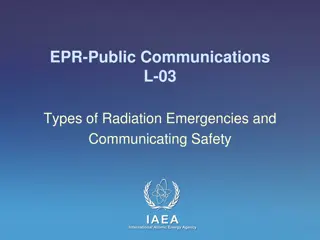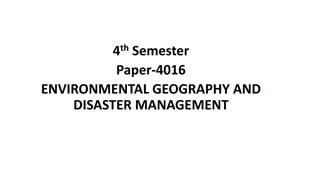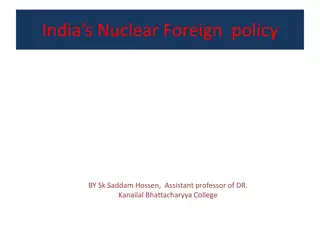Nuclear Emergencies and Disaster Management in India
This article discusses the growth of nuclear technology in India and the risks associated with nuclear and radiological emergencies. It covers the types of nuclear emergencies, emergency response plans, and the institutional mechanisms in place to handle such situations effectively.
Download Presentation

Please find below an Image/Link to download the presentation.
The content on the website is provided AS IS for your information and personal use only. It may not be sold, licensed, or shared on other websites without obtaining consent from the author.If you encounter any issues during the download, it is possible that the publisher has removed the file from their server.
You are allowed to download the files provided on this website for personal or commercial use, subject to the condition that they are used lawfully. All files are the property of their respective owners.
The content on the website is provided AS IS for your information and personal use only. It may not be sold, licensed, or shared on other websites without obtaining consent from the author.
E N D
Presentation Transcript
4thSemester Paper-4016 ENVIRONMENTAL GEOGRAPHY AND DISASTER MANAGEMENT
NUCLEAR EXPLOSIONS The phenomenal growth in the applications of radioisotopes and radiation technology has helped in improving the quality of life of the human race. India is also one amongst the seven declared nuclear weapon states, which uses nuclear technology for strategic purposes. The growth in the application of nuclear science and technology in the fields of power generation, medicine, industry, agriculture, research and defence has led to an increase in the risk of occurrence of Nuclear and Radiological emergencies. India is also one amongst the seven declared nuclear weapon states, which uses nuclear technology for strategic purposes. Nuclear plants, in general, adopt a defense- in-depth approach and multiple physical barriers to ensure that radioactivity is contained at all times. Emergency preparedness and response plans are in place to cope with nuclear or radiological emergency scenarios ranging from minor incidents like a small spillage of radioactive material to a major nuclear accident releasing large-scale radioactivity (like Chernobyl) in the public domain.
However, nuclear emergencies can still arise due to factors beyond the control of the operating agencies; e.g., human error, system failure, sabotage, earthquake, cyclone, flood, etc Nuclear or radiological emergency disaster scenario Any radiation incident resulting in or having a potential to result in exposure to and/or contamination of the workers or the public in excess of the respective permissible limits can be termed is a nuclear/ radiological emergency. These emergencies can be broadly classified in the following manner: 1. An accident-taking place in any nuclear facility of the nuclear fuel cycle. 2. A 'criticality' accident in a nuclear fuel cycle facility where an uncontrolled nuclear chain reaction takes-place.
An accident during the transportation of radioactive material. 4. The Male-volent use of radioactive material as Radiological Dispersal Device (RDD) by terrorists. 5. A large-scale nuclear disaster resulting from a nuclear weapon attack (as had happened at Hiroshima and Nagasaki in Japan), The International Atomic Energy Agency (IAEA) classifies the above emergency scenarios under- two broad categories nuclear and radiological: A nuclear emergency refers to an emergency situation in which there is, or is presumed to be, a hazard due to the release of energy along with radiation from a nuclear chain reaction. All other emergency situations, which have the potential hazard of radiation exposure due to decay of radioisotopes are classified as radiological emergencies.
Institutional mechanism for it The Government of India has identified Department of Atomic Energy (DAE) as the nodal agency for providing the necessary technical inputs to the national or local. The Ministry of Home Affairs (MHA) is the nodal ministry in such emergencies. For this purpose, a Crisis Management Group (CMG) has been functioning since 1987 at DAE. Crisis Management Group (CMG) It is immediately activated and it coordinates with the local authority in the -affected area. All the concerning authorities at the centre (NCMC/ NEC/NDMA)- to ensure that the necessary technical- inputs are available to respond to the nuclear/radiological' emergency.
Medical preparedness for nuclear emergencies In each constituent unit of DAE, a few doctors have been dedicated and given the necessary training in the medical management of radiation emergencies. All nuclear power plants and the Bhabha Atomic Research Centre (BARC) are equipped with radiation monitoring instruments, have personnel decontamination centres and the necessary stock of antidote medicines and specific de-corporation agents for typical radioisotopes. Public awareness To educate the people about the beneficial aspects of nuclear radiation and to remove their misgivings about it, the authorities of nuclear fuel cycle facilities in general, and that of nuclear power stations in particular, are actively involved in carrying out regular public awareness programmes for people living in the vicinity of these facilities.
Mitigation and preparation Goals are: To reduce radiation-induced health effects by preventing. To limit the occurrence of stochastic effects in the population. Domain of Action The response actions within the site boundary of the nuclear facility -are the responsibility of the management of the nuclear facility whereas the implementation of the emergency response plans in the public domain (beyond the site boundary) is the responsibility of the concerned district authority. In the event of an off-site emergency having the potential for trans-boundary effects, necessary action is taken by DAE in accordance with the country's international obligations.
Specialized Response Teams Four battalions of National Disaster Response Force (NDRF) are being specially trained by NDMA with assistance from DAE/DRDO to provide specialized response during a nuclear/radiological emergency/disaster. Role of Civil Defense Selected civil defence personnel will be trained extensively in the subjects of radiation, radioactivity, radiation--protection, use of monitoring instruments, shielding, decontamination, waste disposal, etc. Role of Armed Forces The armed forces will also gear up their nuclear disaster preparedness so that they can be inducted in the event of nuclear disasters.
Periodic Exercises and Mock Drills It focuses on roles and responsibilities resource identification, use of equipment, understanding the effects of radiation on human beings, animals and the environment. Emergency Response Centres (ERCs) ERCs will be set up at all levels (i.e., state .capitals and major cities) with the necessary manpower, instruments and equipment. Depending upon the location and assigned functions, these ERCs will also be maintained in a ready state to quickly respond to any nuclear/ radiological emergency. Radiation Detection, Monitoring Instruments and Protective Gear The first need is the availability of instruments for detecting and monitoring the radiation. An inventory of radiation monitoring instruments and protective gear will be built up by all the SDMAs and DDMAs in consultation with DAE.
Real Time Monitoring Systems A network of simple environmental monitors, the Indian Environmental Radiation Monitoring Network (IERMON) has been established by BARC. These monitors work on a 24 x 7 basis. Source Wikipedia Savindra Singh-Environmental Geography NDMA website
